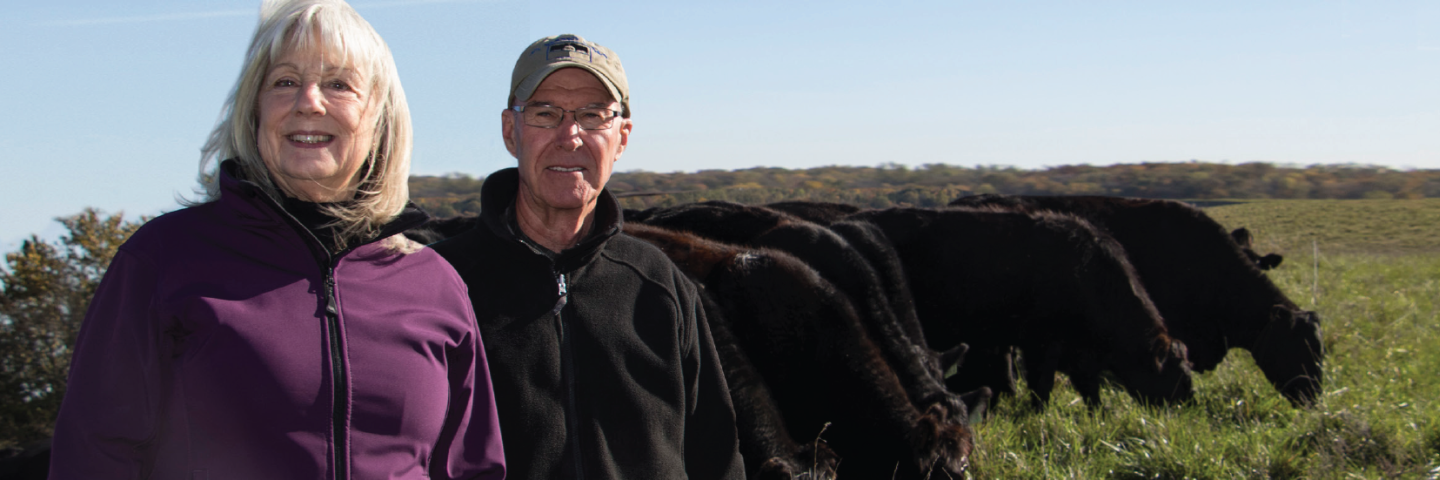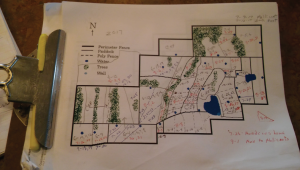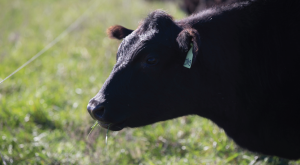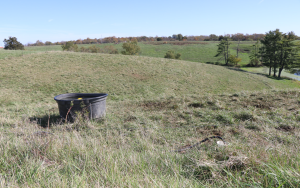
The Quiet Grazier
Jim Burrus
Organic Grass-Fed & Grass-Finished Cattle
Morgan County, IL
In 1946 Jim Burrus’ father, Loren, owned 191 acres in Morgan County. The farm and homestead, located just north of Jacksonville, Illinois had corn, soybeans, wheat and livestock—cows, hogs, and chickens—typical for family farms back then. Like many Illinois farms, the land had steep slopes, but Loren was committed to keeping steep ground in pasture. “Keeping those slopes in grass protects against erosion. That concept holds true on these acres even today,” says Jim. “I have many acres that have never been anything but pasture.”
By the time Jim took the reins in 1979, it was challenging to find ways to make money on a small, rural farm. One winter, Jim read a Pasture Improvement article by Jim Gerrish. Gerrish was a Midwest grazing innovator who co-founded monthly “Missouri Grazing School” seminars to teach farmers the art and science of rotational and intensive grazing techniques. These seminars became a popular educational model still used today.

“I was hooked,” said Burrus realizing the possibilities grazing allowed, the flexibilities it offered. He learned how grass fields protect steep ground and make money at the same time. Burrus attended these seminars and other conferences over the next several years, learning all he could and using new ideas on his own cows and E slopes in Illinois. Today, Jim and wife Mary have 178 acres in an organic rotational grazing and 193 acres in no-till beans, strip-till corn, and organic hay. When pastures are subdivided, he has 62 paddocks to fulfill his grazing plan.
Finding EQIP
Back in 1995, Burrus attended a Wisconsin Grazing Conference and learned about a new federal government program called the Environmental Quality Incentives Program (EQIP). He learned USDA’s Natural Resources Conservation Service (NRCS) would help cover some of the costs to improve pastures and develop a customized Rotational Grazing Plan with materials, fence, water options, and one-on-one technical help.
Burrus signed up for EQIP in 1996 with the Jacksonville NRCS field office and hooked up with an NRCS Grazing Specialist. Because he already had cows, established pastures, and the beginnings of a livestock operation, EQIP was the perfect fit to add to it, customize solutions, address natural resource issues, and improve his land and operation.
Some fence installed through EQIP controlled cattle from full access to the wooded draws where they spent a fair amount of the day. By fencing these areas, he reduced soil erosion and improved water quality and wildlife habitat. Other NRCS conservation practices installed are dry dams and stream bank improvements.
Though Jim started his own water system using the existing pond to pump water to various locations in the pasture, he did not have water where it was most needed due to the expense. NRCS worked with him to use the existing watering system to get water to distant pastures not used to their full potential. Grass in the far reaches wasn’t grazed as much due to the distance the cattle had to travel to reach water. EQIP technical and financial assistance helped Burrus procure 12,000 feet of pipeline, add fencing, and water tanks.
EQIP assistance also included using “quick-connects” to supply and connect pipelines to water tanks. This added to the flexibility of his grazing system. “The quick connects just made more sense for my operation verses installing freeze-proof water hydrants,” Jim says. Quick connects cost less and there is no worry about cattle rubbing on hydrants.
Going Organic!
Deciding to carve out a more profitable niche market, the Burrus Indian Creek operation went organic in 2004, offering organic grass-fed Black Angus beef, chicken, and hay. “I never liked all the chemicals and applications that conventional crops and pastures required,” says Mary. They were both believers in the benefits of more natural, earth-friendly techniques, and they marched forward with their innovative strategy. How did they market their goods? By selling products at local farmers markets, using word of mouth from happy customers, and getting online visibility through Eat Wild & Local Harvest websites.
Mary is herself an “Ivory Girl,” with a back-to-basics use of natural foods, eating and cooking a healthy diet, and using only nature-based beauty & cleaning products “We organically grow a large variety of vegetables in our garden and eat a diet of unprocessed, whole foods strictly limiting grains and sugar. I make my own skin creams using beef tallow, beneficial oils like coconut, emu, jojoba, and essential oils. We follow an alternative health paradigm using diet, quality supplements, and essential oils to maintain health and prevent illness,” Mary explains.

According to Jim, they installed 25’ buffers around the pastures and became certified organic in 2006. The Burrus operation had been holistic for years, so going organic was a natural transition. Being Certified Organic puts the farm in a unique category and provides added work but also added profit margins. Does it involve more paperwork and headaches? Some. Is it worth it? Most definitely!
“Building better soil has been a priority of mine for as long as I can remember. We don’t fertilize our pastures or apply pesticides because they kill the life in the soil. There is an inter-connectedness between microbes in the soil, microbes in the plants, and microbes in the gut of the animals,” said Jim.
The health of Jim Burrus’s cows simply mirrors the health of his soils. “We haven’t had a sick calf here since 1994. We don’t need to vaccinate, deworm, or treat for flies because healthy soils grow healthy grass which makes healthy cows. My cows get all they need from the soil and grasses. We build healthy soils with healthy microbes. That kind of natural resistance is the best,” Burrus adds. He even adds organic apple cider vinegar to the herd’s water supplies. They seem to like it and are in top condition.
According to Mary, what they were doing was different. Jim was a pioneer in many respects, always trying something new, talking to others, and learning more. All these efforts, along with other practices is what helped earn Jim and Mary the 2006 IBA Environmental Steward of the Year and the 2014 Morgan County Conservation Farm Family of the year.
Recent Challenges
For a grazing operation, water access and facilities are critical. Although spring 2017 was wet, the summer was dry. They were forced into ‘survival mode’ after 88 days without rain. Pastures dried up, forcing Jim to feed hay in September. With organic requirements, finding organic hay was hard and pricey. “We contemplated selling some cows,” Jim said. “I never want to have to think about doing that again.”
Finally, with some late rains, Jim’s pastures and healthy soils bounced back. At the end of October, his pastures didn’t look like they experienced drought at all. Proof that healthy soils, good grass, and good herd genetics make a resilient combination. Make sure you have all three!
A Legacy
Every winter Jim sits down and looks over past years grazing history and plans for the coming year. He keeps a record of pasture rotation year to year in order to look back and study trends in production, weather, and his grazing management decisions.
Over the years, Burrus made more improvements, making the land and the soil beneath it even better. He continued to transform the operation, using no-till and strip-till on his grain crops and building the herd up and over 20 head. Today, Jim has 36 cow-calf pairs, 3 bulls, and 20 yearlings. His herd focuses on Black Angus and a few Red Angus.
Weeds? Jim never really had a weed problem except for some thistle, which he took out with sheer persistence. Because his pastures are so thick and healthy, there’s no room for weeds to infiltrate. Nature has her way. And it’s a way that works.
By managing 90 head on 1- to 2-acre paddocks using high stock density and mob gazing techniques (ultra-high stock density grazing), Jim’s pastures are lush and well fertilized. Jim considers all grazing techniques ‘adaptive’ because you always need to make up-to-the-minute management decisions. Jim’s success lies in his never-ending thought process, wise decisions, and always having options. “That’s what makes rotational grazing so complex and so wonderful!”

Burrus has several 13 year-old cows, all had healthy calves in 2017. “We‘ve created a top notch grass-fed genetic line here,” Jim says. “All our cows are born and raised on our farm and have developed a genetic tolerance to fescue. If a cow can’t thrive on our forage, she’s culled. It’s taken a long time to create the high quality level we have here.”
The Burrus operation is a simple one that requires a lot of serious thought and precise, strategic management. Jim is a quiet individual. He’s always thinking about his land, his cows, and his next important decision. He’s built a beautiful landscape, grows content cows, and runs a profitable organic operation.
“My wife grew up a city girl in Jacksonville. She probably never thought she’d live on an organic livestock ranch. But she loves the beauty, peace, and being close to nature out here. She tells me she’d never give it up,” says Jim. Of course, she did suggest Jim talk to NRCS again about upgrading some of his one wire fence so they could leave town and actually go on a vacation once in a while. No doubt Jim will be in touch with NRCS very soon.
To learn how USDA’s NRCS can help your livestock operation or address natural resource concerns, call your local county office today. Visit Illinois NRCS to find the office closest to you.

